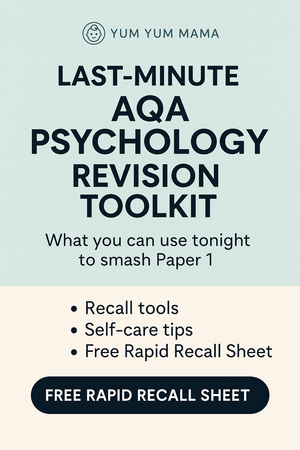Multi Store Model of Memory Evaluation
The Multi Store Model (MSM) of Memory, proposed by Atkinson and Shiffrin (1968), describes memory as a linear process consisting of three separate stores: sensory memory, short-term memory (STM), and long-term memory (LTM). This model has been influential in cognitive psychology, but it also has limitations. In this article, we evaluate the strengths and weaknesses of the Multi Store Model and consider its relevance for AQA A-Level Psychology students.
Want Tailored A* Model Answers Sent Straight to Your Inbox?
Pick your topics below and we’ll send you the exact model essays you need – no fluff, no stress. Just real help for real grades.
What Is the Multi Store Model of Memory?
The Multi Store Model (MSM) explains memory as a system where information flows through distinct stages:
-
Sensory Memory (SM): Information from the environment enters here. It has a large capacity but a very short duration (less than a second).
-
Short-Term Memory (STM): If attention is paid to sensory information, it enters STM, which has a capacity of 7±2 items (Miller, 1956) and a duration of about 18-30 seconds (Peterson & Peterson, 1959).
-
Long-Term Memory (LTM): If information is rehearsed, it transfers to LTM, where it can remain indefinitely.
The model suggests that memory is processed in a linear way, with rehearsal playing a key role in moving information into long-term storage.
Evaluation of the Multi Store Model of Memory
Strengths of the Multi Store Model
1. Supporting Experimental Evidence
One strength of the MSM is that it is supported by research studies that demonstrate distinct memory stores. For example:
-
Miller (1956) found that STM has a capacity of around 7±2 items, supporting the idea of a limited-capacity short-term store.
-
Peterson and Peterson (1959) showed that STM has a short duration (around 18-30 seconds) when rehearsal is prevented, supporting the MSM's claim that rehearsal is necessary for transfer to LTM.
-
Glanzer and Cunitz (1966) demonstrated the primacy and recency effect (serial position effect), supporting the distinction between STM and LTM.
2. Case Studies Support the Model
-
The case of HM (Henry Molaison) provides strong support for the MSM. After surgery to treat epilepsy, HM could not transfer new information from STM to LTM, but his existing LTM remained intact. This suggests separate memory stores, as MSM proposes.
3. Practical Applications
-
Understanding how information transfers to LTM has educational benefits. Techniques such as chunking and rehearsal strategies can improve memory retention, which is particularly useful for students preparing for exams.
Weaknesses of the Multi Store Model
1. Too Simplistic (Reductionist)
The MSM assumes that memory is a single linear process, but research suggests otherwise. The Working Memory Model (Baddeley & Hitch, 1974) argues that STM is more complex, consisting of different components (e.g., phonological loop, visuospatial sketchpad).
2. Overemphasis on Rehearsal
-
MSM suggests that information must be rehearsed to enter LTM, but this is not always the case.
-
Flashbulb memories, such as those formed during traumatic or highly emotional events, transfer to LTM without deliberate rehearsal (Brown & Kulik, 1977).
3. Evidence Against the Model
-
Shallice and Warrington (1970) studied KF, a brain-damaged patient who had an impaired STM for verbal information but could process visual information normally. This challenges the idea that STM is a single store.
How Does the Multi Store Model Explain Memory?
The MSM explains memory as a sequential process, with information flowing from sensory memory to STM and then LTM through rehearsal. However, alternative models like the Working Memory Model provide a more detailed explanation of STM processes.
Why Is the Multi Store Model Reductionist?
The MSM is reductionist because it oversimplifies memory into a basic input-output system. It does not account for different types of LTM (episodic, procedural, semantic) or the complexity of STM.
Conclusion: Is the Multi Store Model Still Relevant?
Despite its limitations, the Multi Store Model was a groundbreaking theory in cognitive psychology and laid the foundation for further research into memory. While newer models like the Working Memory Model provide a more detailed explanation, the MSM remains useful for understanding basic memory processes and has practical applications in learning and education.
Multi Store Model of Memory Evaluation – Example 8 Mark Answer
AO1 (3 Marks) – Describe the Model
The Multi Store Model of Memory (MSM) was proposed by Atkinson and Shiffrin (1968) and describes memory as consisting of sensory memory, short-term memory, and long-term memory. Information moves from SM to STM when attention is paid and from STM to LTM through rehearsal. STM has a limited capacity (7±2 items) and a short duration (18-30 seconds), while LTM has potentially unlimited capacity and duration.
AO3 (5 Marks) – Evaluation
One strength of the MSM is that research evidence supports the existence of separate memory stores (Point). Glanzer and Cunitz (1966) found that participants recalled more words from the beginning and end of a list (primacy and recency effect), which supports the distinction between STM and LTM (Because). This adds credibility to the MSM as a psychological explanation of memory (Why).
However, a limitation of the MSM is that it oversimplifies memory (Point). Shallice and Warrington (1970) studied KF, who had damaged STM for verbal information but intact visual STM, suggesting STM is not a single store (Because). This challenges the MSM’s claim that STM processes all information in the same way, making the model less valid (Why).
Key Takeaways
✅ The MSM is supported by research evidence (e.g., HM, Glanzer & Cunitz, Miller).
✅ It is too simplistic and does not account for different STM components or different types of LTM.
✅ Rehearsal is not always necessary for memory transfer (e.g., flashbulb memories).
✅ The MSM was an important early memory model, but newer models like the Working Memory Model provide a more detailed explanation.



